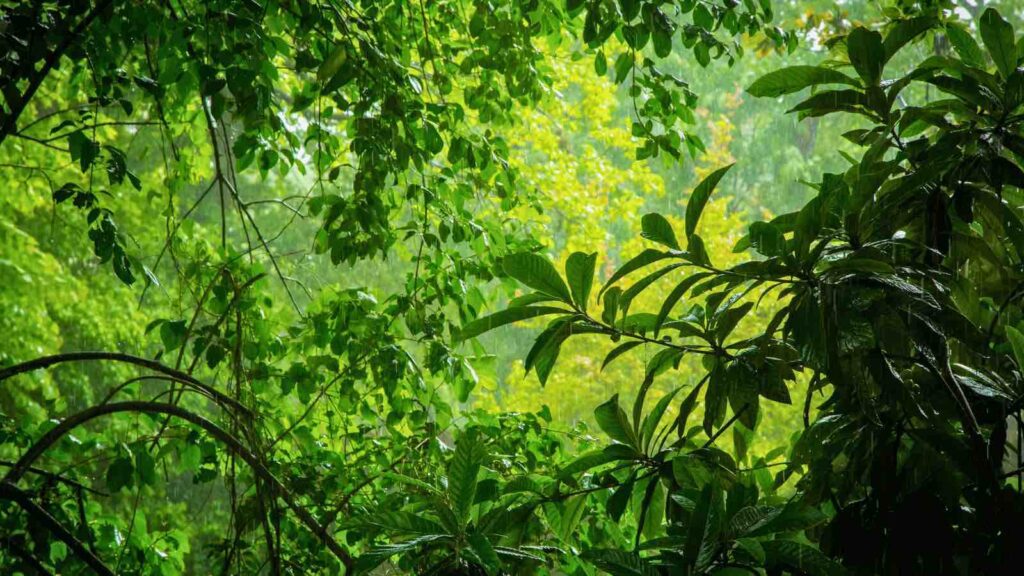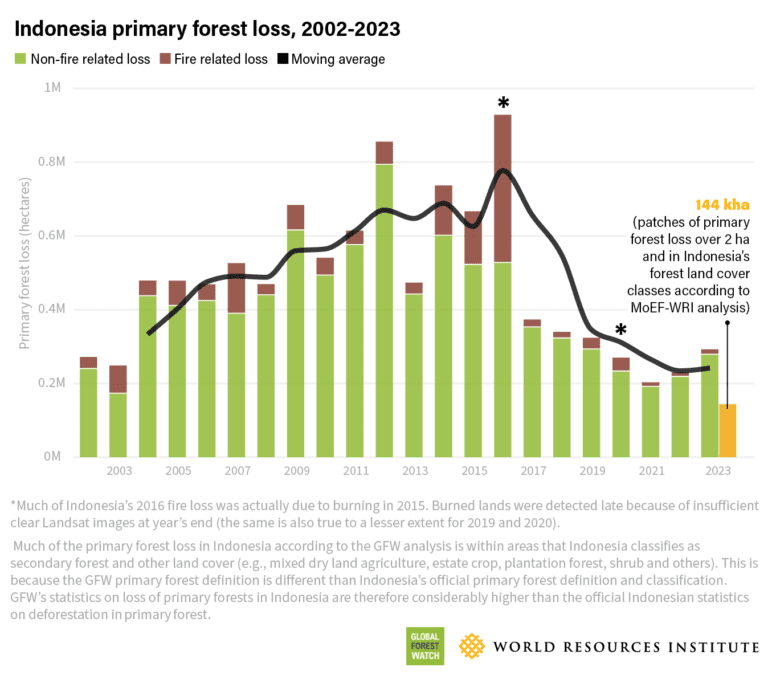The Global Forest Watch (GFW), reveals a sobering trend: 3.7 million hectares of primary tropical forests were lost globally in 2023.
Tropical forest loss continues at an alarming pace, posing serious challenges to achieving the 2030 global zero-deforestation target. New data from the University of Maryland’s GLAD lab, analyzed by the Global Forest Watch (GFW), reveal a sobering trend: 3.7 million hectares of primary tropical forests were lost globally in 2023. While this represents a slight 9% decrease from 2022, the level of loss remains devastatingly high, especially in Southeast Asia. Three countries in Asia—Indonesia, Laos, and Malaysia—are facing significant deforestation challenges and underscore the struggle between forest preservation and economic pressures across the region.
RELEVANT SUSTAINABLE GOALS



Indonesia: Surging Forest Loss Amid Agricultural Expansion
As Southeast Asia’s largest country and the fourth most significant contributor to global primary forest loss, Indonesia saw its deforestation rates surge in 2023. The country reported 290,000 hectares of primary forest lost last year—a 26% increase from 2022. This sharp rise is primarily tied to agricultural and industrial expansion, including palm oil and pulpwood plantations, which continue to drive the country’s economic growth.
The impacts of forest loss are significant: besides biodiversity loss, deforestation in Indonesia contributed 2.4 gigatons of CO₂ emissions in 2023, equating to nearly half the U.S.’s annual fossil fuel emissions. Forest fires, both natural and man-made, compound the issue. Often ignited to clear land for agriculture, fires have devastated vast forested areas in past years and threaten to do so again with growing intensity as climate conditions worsen.
Laos: Forests at Risk Amid Infrastructure Projects and Resource Extraction
Neighboring Laos has likewise struggled with deforestation, with large infrastructure projects and resource extraction activities impacting its forests. The country has suffered extensive forest loss, particularly in regions where industrial agriculture, mining, and hydropower projects are concentrated. Such deforestation threatens not only biodiversity but also disrupts local ecosystems that have sustained Indigenous communities for generations.
According to Global Forest Watch, Laos boasted 17.9 million hectares of natural forest in 2010, covering 78% of its land. But by 2022, the country lost an alarming 322,000 hectares to deforestation, releasing approximately 168 million tons of CO₂ into the atmosphere. This trend continued to worsen by 2023, when another 436,000 hectares of forest disappeared, equating to 237 million tons of CO₂ emissions. While the effects of climate change remain intangible to many, these numbers underscore the very tangible impact of deforestation: an acceleration of global warming, loss of biodiversity, and the degradation of one of the world’s most resilient natural ecosystems.
Malaysia: Forests at Risk Amid Infrastructure Projects and Resource Extraction
Malaysia, a major palm oil producer, is grappling with its own deforestation pressures. While the country reported a smaller amount of forest loss compared to its neighbors, Malaysia’s rainforests continue to face significant threats. Rapid expansion of palm oil plantations has dramatically altered the landscape, with vast forested areas cleared to make way for industrial agriculture.
According to Global Forest Watch, In 2010, Malaysia had 19.8 Mha of natural forest, extending over 87% of its land area. In 2023, it lost 133 kha of natural forest, equivalent to 146 Mt of CO₂ emissions.
The Malaysian government has made some strides in forest protection by setting aside certain areas as reserves. However, demand for commodities and the profitability of palm oil mean deforestation remains a persistent problem. Additionally, large swathes of secondary forests—those that have regrown after prior clearing—are vulnerable to re-clearing for timber and agriculture.
A Global Challenge: The Broader Impact of Tropical Forest Loss in Southeast Asia
Deforestation in Southeast Asia is part of a broader global crisis. Across the humid tropics, 76.3 million hectares of primary forests have disappeared since the early 2000s. Forest loss contributes significantly to climate change through carbon emissions, as trees absorb large amounts of CO₂. The combined effects of industrial agriculture, resource extraction, and shifting cultivation account for nearly 93% of this deforestation.
A significant spike in forest loss occurred in 2016 and 2017, largely due to fires in Brazil and Indonesia—two of the most deforested regions worldwide. Despite global pledges to protect forests, the lack of strict enforcement mechanisms has left many countries, especially in Southeast Asia, falling short of their conservation goals.
The drive to balance economic growth with environmental preservation in Southeast Asia remains challenging. Countries like Indonesia, Laos, and Malaysia have pledged to reduce deforestation, but achieving this goal will require a multifaceted approach. International investment in sustainable industries, community-led conservation projects, and stringent enforcement of deforestation laws could make a difference.
The global 2030 zero-deforestation target remains attainable, but it requires urgent and sustained action. Solutions that bring economic benefits without sacrificing primary forests could help countries across Asia make strides toward this vital goal. By building stronger partnerships with global environmental organizations and investing in sustainable industries, Southeast Asia has the potential to preserve its forests and support both local and international climate commitments.




